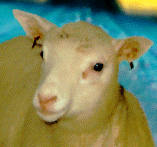How many generations of cloned animals can be created?

By Yanai Ofran
The excitement caused by the birth of Dolly, the first cloned sheep, included, among other things, horror scripts about a world of cloned, identical creatures that would return and clone themselves again and again, until they filled the earth. But an experiment whose results were published two weeks ago in the journal "Nature" reveals a surprising feature of duplicated creatures. The experimenters tried to re-clone cloned mice. Despite great efforts, they were unable to create a lineage of more than six generations of mice that were cloned from each other. The cloned mice look completely normal; So what prevents the seventh clone? An answer to this question is not only important for those who deal with cloning, it may also provide an answer to the question of why we age.
Cloning is basically creating an identical twin. Almost every cell in the body contains the complete genome - the collection of all genes. In the cloning process, a cell of some animal is taken, and the entire genome is extracted from it. This genome is inserted into a fertilized egg that is about to start developing into an embryo. The embryo that will develop from this egg will have the same genetic characteristics as those of the person who donated the genome. Like identical twins, which are two creatures with the same genetic load, two cloned creatures also have the same genetic load, except that they are not the same age.
Why were huge sums invested in the development of this technology? The motivations were mainly agricultural and medical. Some hoped, for example, that it would be possible to clone the best dairy cow in the world, and create huge herds of super-cows.
In the medical field, the main hope is in the field of transplants. In order to transplant organs, one usually has to wait for a donor who has been affected by a disaster, and convince the grieving family to donate their organs. So the organs are transplanted in patients who always have a genetic load different from that of the donor. There is a great danger of rejection of the transplant, and the transplant recipient must always be subjected to dangerous immunosuppression.
The researchers hope that eventually, through the refinement of cloning technologies, it will be possible to grow a copy of their heart for every person. Such technology will avoid the need to look for a donor, not to mention the fact that such a step will not be rejected by the body. It is a new and young copy of the damaged heart.
young? This question has been debated. Some have claimed that the body cells of cloned beings "remember" the true age of the cell from which they evolved, therefore cloned beings are always older than their true age.
How can the cells "remember" the age of the person from whom they were replicated? The prevailing theory blames the telomeres. The telomeres are the ends of the chromosomes, on which the genes are located. According to this theory, every time a cell divides its telomeres shorten. The shortening of the telomeres, it is claimed, is one of the main causes of aging. When the telomeres are too short, the cell can no longer divide. When the chromosomes are removed from a cell and transferred to a fertilized egg, the length of the telomeres corresponds to the age of the animal from which the genes were taken. Therefore, in order to calculate the age of the body cells of the cloned creature, you actually have to count the time that has passed since the original "parent" was born.
The new study attempted to test these claims. The researchers, led by Truhiko Wakayama from the University of Honolulu and Rockefeller University in New York, tried to repeatedly clone the same mouse. From each cloned mouse they took many hundreds of cells, extracted the genome from them, and tried to insert it into fertilized eggs. The success rate of the technology today is around two percent - that is, about two percent of the eggs that undergo this treatment do eventually become embryos.
These were also Wakayama's success rates in the first generation. But surprisingly, with each generation the percentage of success decreased. In one of the lineages, already in the fifth generation, the cloning attempts failed, despite many hundreds of attempts. In another lineage, the researchers succeeded after hundreds of attempts in creating one mouse in the sixth generation of the lineage. Disappointingly, this mouse was eaten by the mouse that gave birth to it before it was even a day old. This cannibalism decimated the lineage, and once again the researchers were unable to renew it.
What caused these failures? All attempts to find a convincing explanation came to naught. The researchers were of course quick to check the length of the telomeres in each generation of the cloned lineages. The findings were surprising. Not only were the telomeres not shorter than expected according to the telomeres theory, but in some cases they were even slightly longer. In any case, the length of the telomeres was always within the normal range compared to non-cloned mice of the same age.
If everything is so normal, why can't the researchers clone these mice? No one has an answer yet, but it seems that such an answer would be very helpful not only in realizing the dream of those huge herds of super cows, but also in understanding the causes of old age.
{Appeared in Haaretz newspaper, 3/10/2000{
https://www.hayadan.org.il/BuildaGate4/general2/data_card.php?Cat=~~~300378026~~~50&SiteName=hayadan
